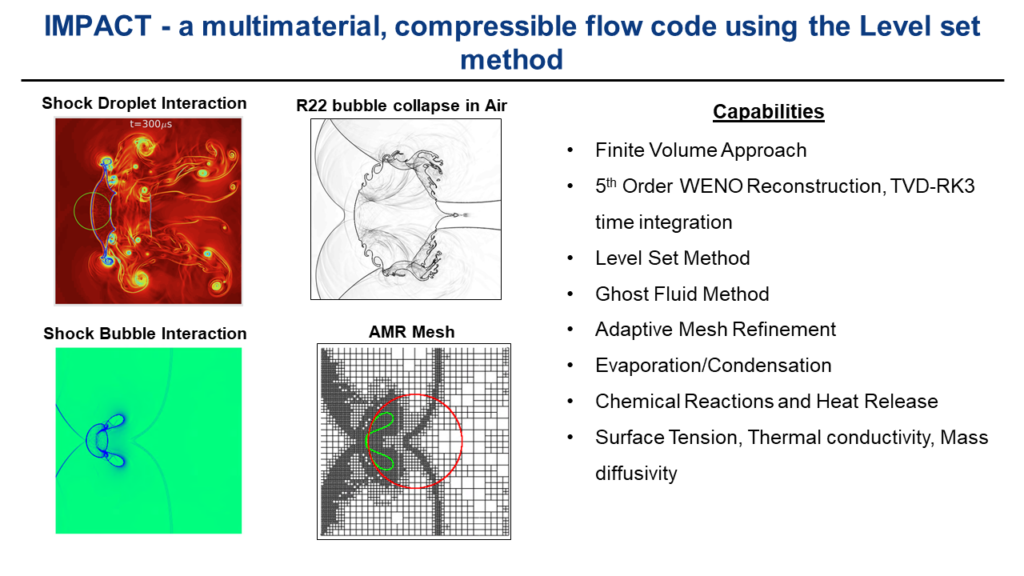IMPACT is an in-house Direct Numerical Simulation (DNS) tool developed at CHAMP, and a multiphase, shock physics code. IMPACT is capable of simulating multimaterial problems with sharp interfaces, with accurate representation of interfacial physics and surface tension effects. A modified version of the Ghost Fluid method [1] is used to represent boundary conditions between different materials across an interface. Key highlights include the use of the level set method for sharp representation of interfaces (without numerical diffusion), surface tension, evaporation and condensation, sublimation, ablation, detailed temperature-dependent transport properties, multiple equations of state, and chemical reactions and combustion. A fifth-order WENO procedure is employed for spatial discretization, while time integration is performed to third-order accuracy through a Total Variation Diminishing Runge-Kutta (TVD RK) scheme. IMPACT is a massively parallel code and uses Adaptive Mesh Refinement (AMR) implemented using the PARAMESH software.

In IMPACT, the level set method [2] is used to implicitly track the interface morphology and position through a wide range of physical processes, including stretching, pinchoffs and breakup, droplet mergers, and hole nucleation without resorting to expensive front tracking or interface reconstruction. To ensure mass conservation to a high degree of accuracy, the signed distance function used in the level set method is frequently reinitialized. When combined with an AMR mesh, this approach has been demonstrated to minimize mass conservation errors associated with level set methods. IMPACT has been extensively validated for a wide range of multiphysics test problems including underwater explosions, shock interaction with a Helium bubble embedded in water, Richtmyer-Meshkov instability with and without surface tension, shock-droplet interaction etc.
Sharp interface methods used in shock physics codes are often affected by oscillatory errors near material interfaces. These errors take the form of local overshoots and undershoots, particularly when the density differences between the materials on either side of the interface is large. In IMPACT, we use a novel numerical scheme recently developed by our research group, called the Efficient Ghost Fluid Method, that effectively eliminates such errors in compressible multi-medium flows. The EGFM approach relies on correcting cell values near the interface based on exact solutions to the local multimedium Riemann problem. For cells further away from the interface, a fix is applied either based on the isentropic or shock relations. In addition to eliminating oscillatory errors completely (see examples in figure below), this approach also results in accurate computation of locations of shocks and rarefactions, and has a higher order of accuracy compared to other GFM-based approaches.
References:
- R.P. Fedkiw, T. Aslam, B. Merriman, & S. Osher, “A non-oscillatory Eulerian approach to interfaces in multimaterial flows (the Ghost Fluid Method”, J. Comp. Phys., 152, 457 – 492 (1999).
- S. Osher & R.P. Fedkiw, “The level set methods and dynamic implicit surfaces”, New York, NY: Springer (2023).
Related Publications:
- P. Bigdelou, C. Liu, P. Tarey & P. Ramaprabhu, “An efficient Ghost Fluid Method to remove overheating from material interfaces in compressible multi-medium flows”, Computers & Fluids, 233, 105250, (2022): https://doi.org/10.1016/j.compfluid.2021.105250
